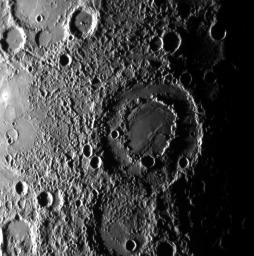Seeing Double?
Caption:
This image shows a double-ring impact basin, with another large impact crater on its south-southwestern side. Double-ring basins are formed naturally when a large meteoroid strikes the surface of a rocky planet. Smaller, more recent impacts also formed comparatively fresh craters across the entire surface visible in this image. The floor within the inner or peak ring appears to be smoother than the floor between the peak ring and the outer rim, possibly the result of lava flows that partially flooded the basin some time after impact.
Date Acquired:
September 29, 2009
Image Mission Elapsed Time (MET):
162744214
Instrument:
Narrow Angle Camera (NAC) of the Mercury Dual Imaging System (MDIS)
Resolution:
400 meters/pixel (0.25 mile/pixel)
Scale:
The double-ring basin is approximately 160 kilometers in diameter (100 miles)
Spacecraft Altitude:
15,400 kilometers (9,600 miles)
Background Info:
This image and caption were prepared by MESSENGER Educator Fellows Christina Dorr (Hilliard City School District, Hilliard, OH) and Julie Taylor (Adelanto School District, Adelanto, CA). For more information on the MESSENGER Educator Fellows program,
click here
.
These images are from MESSENGER, a NASA Discovery mission to conduct the first orbital study of the innermost planet, Mercury. For information regarding the use of images, see the MESSENGER
image use policy
.
Cataloging Keywords:
| Name |
Value |
Additional Values |
| Target |
Mercury |
|
| System |
|
|
| Target Type |
Planet |
|
| Mission |
MESSENGER |
|
| Instrument Host |
MESSENGER |
|
| Host Type |
Orbiter |
|
| Instrument |
Mercury Dual Imaging System (MDIS) |
|
| Detector |
Narrow Angle Camera (NAC) |
|
| Extra Keywords |
Crater, Grayscale, Impact |
| Acquisition Date |
|
| Release Date |
2009-10-01 |
| Date in Caption |
2009-09-29 |
|
| Image Credit |
NASA/Johns Hopkins University Applied Physics Laboratory/Carnegie Institution of Washington |
| Source |
photojournal.jpl.nasa.gov/catalog/PIA12272 |
| Identifier |
PIA12272 |

 Planetary Data System
Planetary Data System
